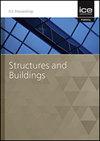事半功倍:使用高强度钢材,提高材料效率
IF 1.4
4区 工程技术
Q3 CONSTRUCTION & BUILDING TECHNOLOGY
Proceedings of the Institution of Civil Engineers-Structures and Buildings
Pub Date : 2022-02-24
DOI:10.1680/jstbu.21.00143
引用次数: 2
摘要
高强度钢(HSS)的使用使构件具有更小的横截面,或更轻,或两者兼而有之。减重的程度取决于构件的类型和加载方式。更轻的部分导致减少碳排放,通常,更低的材料成本。重量的减轻还可以节省基础、焊接、制造、运输和安装的成本。由于这些优点,高强度钢越来越多地应用于建筑领域,特别是重型柱、转换梁、桁架和桥梁大梁。为了充分发挥高强度的优势,高速钢设计和制造的某些方面需要特别注意。2018年,ICE为SCI提供了一笔ICE研发基金的资助,用于编写一份指南,涵盖屈服强度从420 MPa到700 MPa的HSS的设计和执行,提供强度,稳定性,适用性和制造的“整体”指导。《高强度钢设计和执行指南》是与钢结构供应链专家合作编写的,并于2020年出版。本文章由计算机程序翻译,如有差异,请以英文原文为准。
More from less: Greater materials efficiency using high strength steels
The use of high strength steels (HSS) enables members to have smaller cross-sections, or be lighter, or both. The extent of the weight savings depends on the type of member and the mode of loading. Lighter sections lead to reductions in carbon and, usually, lower material costs. The reduction in weight can also lead to a cost saving in the foundations, welding, fabrication, transportation and erection. As a result of these benefits, steels of higher strength are being used increasingly in a range of applications in construction, particularly for heavy columns, transfer beams, trusses and bridge girders. Certain aspects of the design and fabrication of HSS require special attention in order to exploit fully the benefits of the high strength. In 2018, ICE awarded a grant from the ICE Research and Development Enabling Fund for SCI to write a guide covering both design and execution of HSS of yield strength from 420 MPa up to 700 MPa, giving ‘holistic’ guidance covering strength, stability, serviceability and fabrication. The High Strength Steel Design and Execution Guide, was written in collaboration with experts in the steel construction supply chain, and was published in 2020.
求助全文
通过发布文献求助,成功后即可免费获取论文全文。
去求助
来源期刊
CiteScore
3.40
自引率
6.20%
发文量
61
审稿时长
12 months
期刊介绍:
Structures and Buildings publishes peer-reviewed papers on the design and construction of civil engineering structures and the applied research associated with such activities. Topics include the design, strength, durability and behaviour of structural components and systems.
Topics covered: energy conservation, people movement within and around buildings, strength and durability of steel and concrete structural components, and the behaviour of building and bridge components and systems

 求助内容:
求助内容: 应助结果提醒方式:
应助结果提醒方式:


